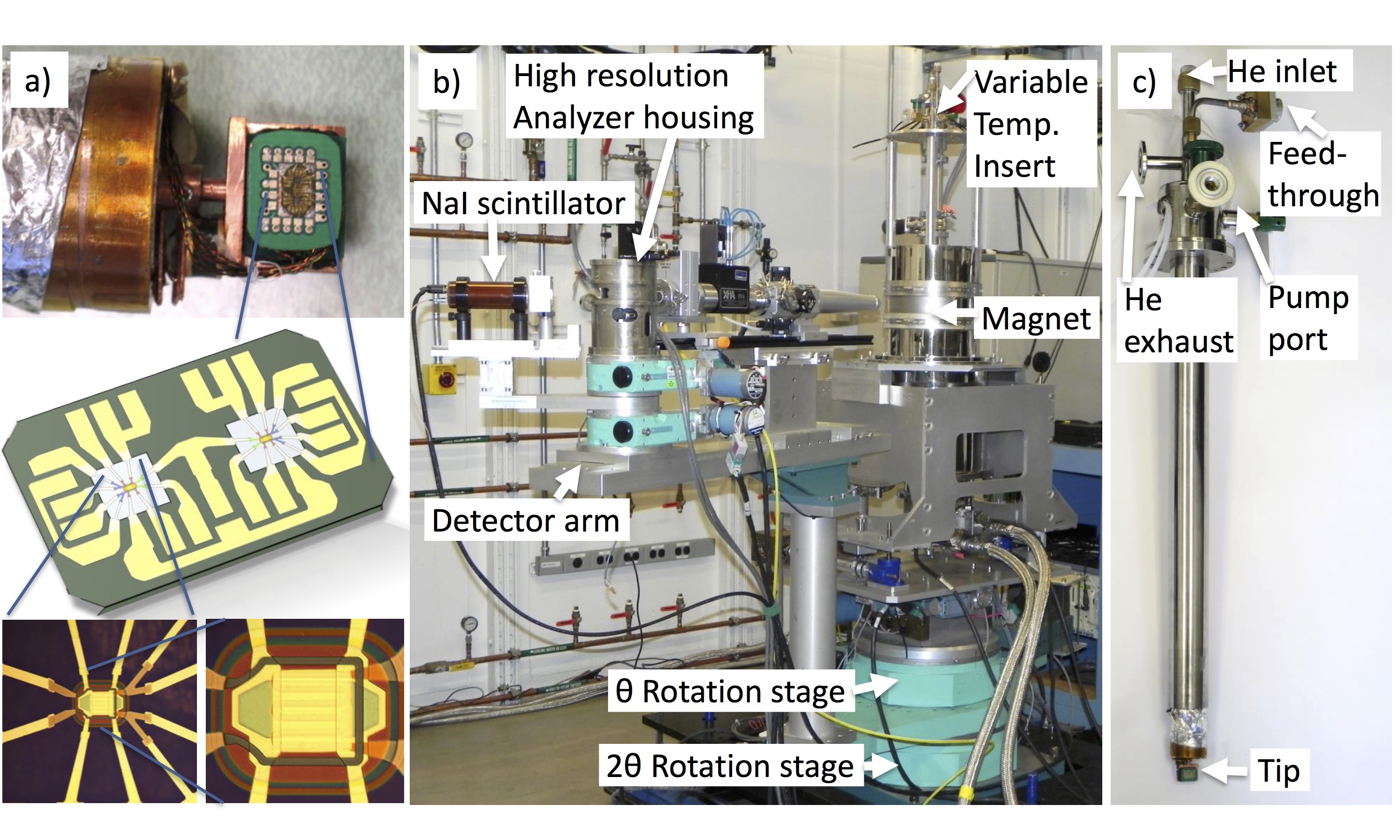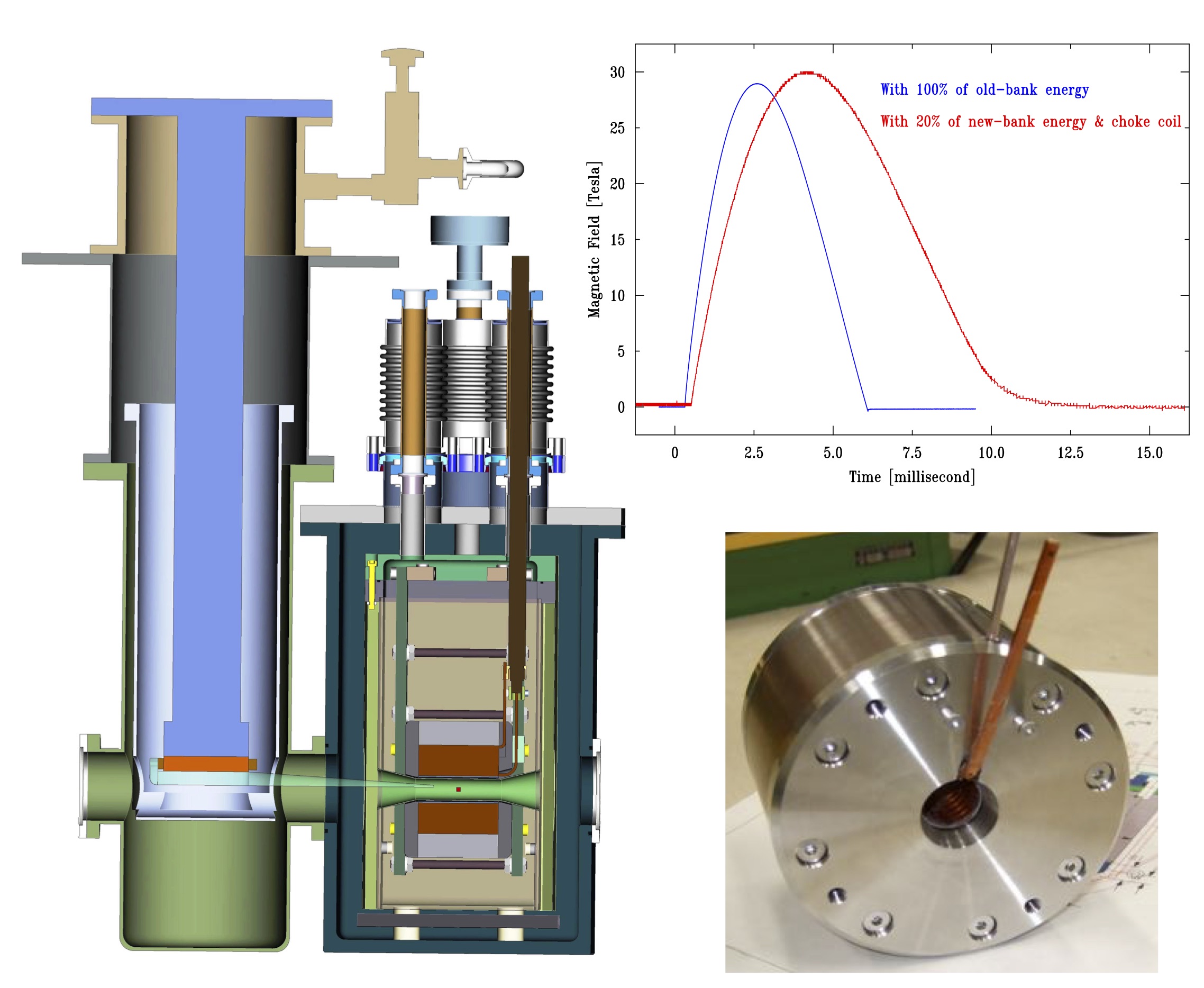|
6-ID-C is focused on diffraction studies in magnetic fields. A cryogen-free 4.5 Tesla superconducting (SC) magnet and a 30 Tesla pulsed-field (PF) magnet are available. References below can be consulted for details of resonant and non-resonant scattering studies, instrument capabilities, and scientific areas explored. Scattering experiments spanning an x-ray energy range of 7-30 keV have been performed. Magnetic field and temperature ranges routinely available are listed in the following table:
|
|||||||||
| Magnet Diffractometer | |||||||||
|
There are ongoing R&D efforts to use nano-calorimetry concurrently with x-ray scattering in 4 Tesla superconducting magnet. (a) Calorimeter on cryostat cold finger together with optical microscopy images of the nanocalorimeter cell and a sketch of the chip. A thermometer and an offset heater allow one to control and stabilize the temperature of the sample, while the ac heater enables specific heat measurements. (b) Diffractometer with split-pair magnet mounted. The nanocalorimeter is attached to the tip of a cold finger helium flow cryostat (c), which is inserted inside the superconducting split-pair vertical-field magnet resulting in a magnetic field parallel to the membrane.
Left: 30 Tesla double-cryostat setup for sample and solenoid; Upper right: use of a choke coil stretches magnetic field pulse profile; Lower right: Large bore solenoid. |
|||||||||
| In-field scattering references | |||||||||
|
Alejandro Ruiz, Alex Frano, Nicholas P. Breznay, Itamar Kimchi, Toni Helm, Iain Oswald, Julia Chan, R.J. Birgeneau, Zahirul Islam, and James G. Analytis, "Correlations states in β-Li2IrO3 driven by applied magnetic fields." Nature Communications 8 October, 2017 doi: 10.1038/s41467-017-01071-9. K. Willa, Z. Diao, D. Campanini, U. Welp, R. Divan, M. Hudl, Z. Islam, W.-K. Kwok, “Nanocalorimeter platform for in situ specific heat measurements and x-ray diffraction at low temperature,” Rev. Sci. Instrum. 88, 125108 (2017) H. Jang, W.-S. Lee, H. Nojiri, S. Matsuzawa, H.Yasumura, L. Nie, A.V. Maharaj, S. Gerber, Y.-J. Liu, A. Mehta, D.A. Bonn, R. Liang, W.N. Hardy, C.A. Burns, Z. Islam, S. Song, J. Hastings, T.P. Devereaus, Z.-X. Shen, S.A. Kivelson, C.-C. Kao, D. Zhu, J.-S. Lee, “Ideal charge-density-wave order in the high-field state of superconducting YBCO,” Proc. Natl. Acad. Sci. 113, 14645 (2016). S. Gerber, H. Jang, H. Nojiri, S. Matsuzawa, H. Yasumura, D.A. Bonn, R. Liang, W.N. Hardy, Z. Islam, A. Mehta, S. Song, M. Sikorski, D. Stefanescu, Y. Feng, S.A. Kivelson, T.P. Devereaux, Z.-X. Shen, C.-C. Kao, W.-S. Lee, D. Zhu, J.-S. Lee, “Three-Dimensional Charge Density Wave Order in YBa2Cu3O6.67 at High Magnetic Fields,” Science 350, 949 (2015) J. P. Clancy, K.W. Plumb, C.S. Nelson, Z. Islam, G. Cao, T. Qi, Young-June Kim, “Field-induced magnetic behavior of the bilayer iridate Sr3Ir2O7,” arXiv:1207.0960 (2012). A. Skaugen, D.K. Shukla, R. Feyerherm, E. Dudzik, Z. Islam, J. Strempfer, “Magnetic order in GdMnO3 in magnetic fields,” J. Phys.: Conf. Ser. 519, 012007 (2014) Y. Feng, D. M. Silevitch, J. Wang. A. Palmer, N. Woo, J.-Q. Yan, Z. Islam, A. V. Suslov, P. B. Littlewood, and T. F. Rosenbaum, “Evolution of incommensurate spin order with magnetic field and temperature in the itinerant antiferromagnet GdSi,” Phys. Rev. B 88, 134404 (2013) Z. Islam, H. Nojiri, J. P. C. Ruff, R. K. Das, D. Capatina, and J. C. Lang, “Precision X-ray diffraction studies in high pulsed magnetic fields at the Advanced Photon Source", Sync. Rad. News (Focus Issue on Extreme Conditions) 25, 5 (2012).” J. P. C. Ruff, J.-H. Chu, H.-H. Kuo, R. K. Das, H. Nojiri, I. R. Fisher, and Z. Islam, “Susceptibility Anisotropy in an Iron Arsenide Superconductor Revealed by X-Ray Diffraction in Pulsed Magnetic Fields,” Phys. Rev. Lett. 109, 027004 (2012). Z. Islam, J. P. C. Ruff, K. A. Ross, H. Nojiri, and B. D. Gaulin, “Time-resolved one-dimensional detection of x-ray scattering in pulsed magnetic fields,” Rev. Sci. Instrum. 83, 013113 (2012). Z. Islam, D. Capatina, J. P. C. Ruff, Ritesh K. Das, E. Trakhtenberg, H. Nojiri, Y. Narumi, U. Welp, and P. C. Canfield, “A single-solenoid pulsed-magnet system for single-crystal scattering studies,” Rev. Sci. Instrum. 83, 035101 (2012). J. P. C. Ruff, Z. Islam, R. K. Das, H. Nojiri, J. C. Cooley, and C. H. Mielke, “A robust but disordered collapsed-volume phase in a cerium alloy under the application of pulsed magnetic fields,” Phys. Rev. B 85, 024104 (2012). D. Capatina, Z. Islam, E. Trakhtenberg, H. Nojiri, and Y. Narumi, “Mechanical design of a dual-cryostat instrument for a high-field pulsed magnet,” Diamond Light Source Proceedings 1, e42, MEDSI-6 (2010); doi:10.1017/S2044820110000730. Z. Islam, Jacob P. C. Ruff, H. Nojiri, Y. H. Matsuda, K. A. Ross, B. D. Gaulin, Z. Qu, and J. C. Lang, A portable high-field pulsed-magnet system for single-crystal x-ray scattering studies, Rev. Sci. Instrum. 80, 113902 (2009). X. S. Xu, M. Angst, T. V. Brinzari, R. P. Hermann, J. L. Musfeldt, A. D. Christianson, D. G. Mandrus, S. McGill, J.-W. Kim, Z. Islam, “Charge order, dynamics, and magnetostructural transition in multiferoic LuFe2O4”, Phys. Rev. Lett. 101, 227602 (2008). L. Tan, A. Kreyssig, S. Nandi, S. Jia, Y. B. Lee, J. C. Lang, Z. Islam, T. A. Lograsso, D. L. Schlagel, V. K. Pecharsky, K. A. Gschneidner, P. C. Canfield, B. N. Harmon, R. J. McQueeney, A. I. Goldman, “Spin-flop transition in Gd5Ge4 observed by x-ray resonant magnetic scattering and first-principles calculations of magnetic anisotropy”, Phys. Rev. B 77, 064425 (2008). J. Li, D. Vaknin, S. L. Bud’ko, P. C. Canfield, D. Pal, M. R. Eskildsen, Z. Islam, and V. G. Kogan, “Magnetic-field-induced orientation of superconducting MgB2 crystallites determined by x-ray diffractionPhys. Rev. B 74, 064502(2006) |
| Dissertation |
|
Ph.D. theses that have utilized in-field scattering capabilities are listed below. A diversity of resonant and non-resonant scattering experiments have been performed, which might provide valuable guidance in preparing general user proposals for such studies.
|


